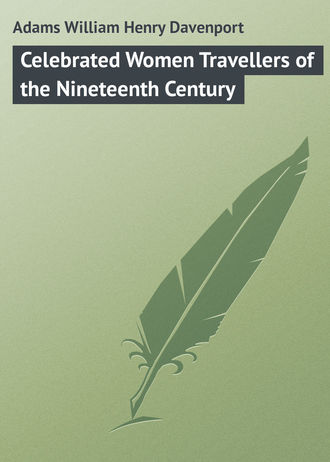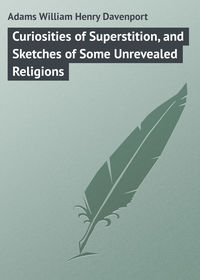 полная версия
полная версияCelebrated Women Travellers of the Nineteenth Century
Lady Florence Dixie frankly tells us her reason for venturing into Patagonia, and no doubt it is the reason which has actuated many of her sisters in their world-wanderings. She went to "an outlandish place so many miles away" – as her friends called it – "precisely because it was an outlandish place and so far away." She adds: "Palled for the moment with civilization and its surroundings, I wanted to escape somewhere where I might be as far removed from them as possible. Many of my readers have doubtless felt the dissatisfaction with oneself and everybody else that comes over one at times in the midst of the pleasures of life; when one wearies of the shallow artificiality of modern existence; when what was once excitement has become so no longer, and a longing grows up within one to taste a more vigorous unction than that afforded by the monotonous round of society's so-called pleasures."
In this state of mind she looked round for some country that would satisfy her requirements, and decided upon Patagonia, because nowhere else could she find an area of 100,000 square miles for "equestrian exercise," where one would be free from the presence of savage tribes and obnoxious animals, as well as from the persecution of morning calls, invitations, garden parties, telegrams, letters, and all the other "resources of civilization." To these attractions was added the thought, always alluring to an active mind, that there she would be able to penetrate into vast wilds, untrod as yet by the foot of man. "Scenes of infinite beauty and grandeur might be lying hidden in the silent solitude of the mountains which bound the barren plains of the Pampas, into whose mysterious recesses no one as yet had ever ventured. And I was to be the first to behold them! – an egotistical pleasure, it is true; but the idea had a great charm for me, as it has had for many others."
Accompanied by her husband, brothers, and three friends, Lady Florence left Liverpool on the 11th December, 1878. Early in January they reached Rio de Janeiro, of which she furnishes a pleasantly graphic sketch, that gives a true idea of her descriptive powers. "Nowhere," she says, "have the rugged and the tender, the wild and the soft, been blended into such exquisite union as at Rio; and it is this quality of unrivalled contrasts that, to my mind, gives to that scenery its charm of unsurpassed loveliness. Nowhere else is there such audacity, such fierceness even of outline, coupled with such multiform splendour of colour, such fairy-like delicacy of detail. As a precious jewel is encrusted by the coarse rock, the smiling bay lies encircled by frowning mountains of colossal proportions and the most capricious shapes. In the production of this work the most opposite powers of nature have been laid under contribution. The awful work of the volcano – the immense boulders of rock which lie piled up to the clouds in irregular masses – have been clothed in a brilliant web of tropical vegetation, purple and green, sunshine and mist. Here nature revels in manifold creation. Life multiplies itself a millionfold, the soil bursts with exuberance of fertility, and the profusion of vegetable and animal life beggars description. Every tree is clothed with a thousand luxuriant creepers, purple and scarlet-blossomed; they in their turn support myriads of lichens and other verdant parasites. The plants shoot up with marvellous rapidity, and glitter with flowers of the rarest hues and shapes, or bear quantities of luscious fruit, pleasant to the eye and sweet to the taste. The air resounds with the hum of insect-life; through the bright green leaves of the banana skim the sparkling humming-birds, and gorgeous butterflies of enormous size float, glowing with every colour of the rainbow, on the flower-scented breezes. But over all this beauty – over the luxuriance of vegetation, over the softness of the tropical air, over the splendour of the sunshine, over the perfume of the flowers – Pestilence has cast her fatal miasmas, and, like the sword of Damocles, the yellow fever hangs threateningly over the heads of those who dwell among these lovely scenes."44
After touching at Monte Video, Lady Florence Dixie's party proceeded southwards to the Straits of Magellan, and landed at Sandy Point, a settlement belonging to the Chilians, who call it "La Colonia de Magellanes." Here they procured horses and mules and four guides, and, having completed all the necessary arrangements, rode along the shore of the famous Strait to Cape Negro. On the opposite side they could distinctly see the Tierra del Fuego, and at different points tall columns of smoke rising up into the still air denoted the presence of native encampments, just as Magellan had seen them four centuries ago, when he gave to the island, on that account, the name it still bears. At last they started into the interior, and began their exploration of the wide region of the Pampas. Game was plentiful, and the fowling-pieces of the party brought down numerous victims. As they advanced they came into occasional contact with the Patagonians, and her observations of their physical character are important and valuable in relation to the marvellous accounts which we find in the old voyagers. "I was not so much struck by their height," she says, "as by their extraordinary development of chest and muscle. As regards their stature, I do not think the average height of the men exceeded six feet, and, as my husband stands six feet two inches, I had a favourable opportunity for forming an accurate estimate. One or two there were, certainly, who towered far above him, but these were exceptions. The women were mostly of the ordinary height, though I noticed one who must have been quite six feet, if not more."
Lady Florence speaks of the features of the pure-bred Tchuelche, or Patagonian aboriginal as extremely regular, and by no means unpleasant to look at. "The nose is generally aquiline, the mouth well-shaped and beautified by the whitest of teeth, the expression of the eye intelligent, while the form of the whole head indicates the possession of considerable mental capabilities. But such is not the case with the Tchuelches in whose veins is a mixture of Fuegian or Araucanian blood. Of these latter the flat noses, oblique eyes, and badly proportioned figures excite disgust, and they are as different from a pure-bred Tchuelche as a racer is from an ordinary cart-horse. Their long coarse hair is worn parted in the middle, and is prevented from falling over their faces by means of a handkerchief, or fillet of some kind, bound round the forehead. They suffer no hair to grow on the face, and some extract even their eyebrows. Their dress is simple, consisting of a 'chiripa' or piece of cloth round the loins, and the indispensable guanaco cape, which is hung loosely over the shoulders and held round the body by the hand, though it would obviously seem more convenient to have it secured round the waist with a belt of some kind. Their horse-hide boots are only worn, for reasons of economy, when hunting. The women dress like the men except as regards the chiripa, instead of which they wear a loose kind of gown beneath the cape, which they fasten at the neck with a silver brooch or pin. The children are allowed to run about naked till they are five or six years old, and are then dressed like their elders. Partly for ornament, partly also as a means of protection against the wind, a great many Indians paint their faces, their favourite colour, as far as I could see, being red, though one or two I observed had given the preference to a mixture of that colour with black, a very diabolical appearance being the result of this combination."
We cannot follow Lady Florence Dixie through all her Patagonian experiences, which in their infinite variety must have fully satisfied her craving for new things. She hunted pumas, ostriches, guanacos; witnessed the wild and wayward movements of the wild horses on the plains, which for ages have belonged unto them; suffered from the burden of the heat, and the attacks of the gnats; explored the recesses of the Cordilleras, and came upon a broad and beautiful lake, on which, in all probability, no human eye before had ever looked; until at last she grew weary of adventure, and she and her companions turned their faces once more towards the commonplace comforts of civilization. All this, and more, she tells with much animation, quite unaffectedly, and in a style which, if marked by no special literary merit, is always clear and vigorous. One can do much worse than while away an hour by the fireside with Lady Florence Dixie's book in one's hand. One will close it with the conviction that the writer is a courageous, lively, and intelligent woman, who can ride across country with a firm hand, and hold her own in any dangerous or novel position.
Not inferior to her in courage and endurance, and her superior in literary qualifications, is Miss Gordon Cumming, who, I think, among female travellers has no rival except Ida Pfeiffer. The worthy representative of a name famous in the annals of adventure and enterprise, she has put a girdle round about the world with unfailing ardour, and plunged into the remote and almost inaccessible regions of the great Asiatic table-land. Her first book, "From the Hebrides to the Himalayas," attracted a great deal of attention by the freshness of its sketches, the grace of its style, the unconventionality of its treatment, and by the space which its author devoted to popular superstitions and antiquities. Her pictures of life in Tibet, of the scenery of the Himalayas, of the manners and customs of the Indian people, of Benares and Hurdwar and Agra, were all so bright and clear as to indicate the pencil of no ordinary artist. Miss Gordon Cumming next betook herself to the Pacific, and spent two years "at Home in Fiji;" two years which she utilized in the collection of much interesting material. She was preparing in 1880 to return to England, when an opportunity was offered to her of effecting that return in a manner which could not but be delightful to a lady of adventurous disposition, with a proper scorn for social "Mrs. Grundyism." A French man-of-war, the Seignelay, which was carrying a Roman Catholic bishop on a cruise round his oceanic diocese, arrived at Levaka, and its officers making the acquaintance of Miss Cumming, courteously invited her to accompany them on the remainder of their cruise. There was a delightful originality in the invitation, and a no less delightful originality in the acceptance of it. The French officers fitted up a pretty little cabin for her accommodation, and without more ado she took up her quarters on board the Seignelay, with no other escort or chaperonage than that of the good bishop.
From Fiji the Seignelay proceeded to Tonga, in the Friendly Islands, where, in the usages of the population and in the insular antiquities, Miss Cumming found much to interest her and her readers. As might be expected, the old picturesqueness of the native life is fast disappearing under the pressure of Western civilization, and we have reason to be thankful to those travellers who do their best to catch its waning features, and transfer them as faithfully as may be to the printed page. The chief archæological curiosities here are the tombs of the old Tongan kings, cyclopean monuments built up of huge volcanic blocks, which seem to have been brought from the Wallis group of islands in open canoes, and erected on their present site with an immense expenditure of human labour. Scarcely less remarkable is the great solitary dolmen, which still exists intact, though of its origin nothing is known, even in tradition. But that it marks the last resting-place of some great chief or hero may be inferred from the fact that until within the last few years an immense Kana tent stood upon the transverse capstone of the dolmen, and that feasts were celebrated on the spot. As Miss Cumming reminds, similar celebrations take place in many parts of Britain and Brittany "at the stones" to the present day.
From Tonga Miss Cumming was conveyed to Samoa, where she was very hospitably received by the Samoan notables, and might have enjoyed herself greatly, but for the civil war in which the group is always plunged. It is to the credit of the inhabitants, however, that they agree to abstain from fighting on at least one day of the week. In their manners and customs they retain more of the primitive simplicity than is found now-a-days in most of the Polynesian islands.
Her descriptions of Tahiti, the Eden of the Pacific, are not less glowing than those of her predecessors, from Wallis and Bougainville down to "the Earl and the Doctor." They are full of warm, rich colour, as might have been expected from one who is an artist as well as an author, and set before us such a succession of vivid and enchanting landscapes as hardly any other portion of this wide, wide world can parallel; for with the bold majesty of Alpine peaks is combined the luxuriant grace of tropical forests, and valleys as beautiful as that of Tempe open out upon a boundless ocean as blue as the sky it glasses. Add to this that the vegetation has a charm of its own – the feathery palm and the bread-fruit tree lending to it a quite distinctive character. Here is a vignette, which will give the reader some notion of this enchanting Tahitian scenery: – "We rode along the green glades, through the usual successions of glorious foliage; groves of magnificent bread-fruit trees, indigenous to those isles; next a clump of noble mango-trees, recently imported, but now quite at home; then a group of tall palms, or a long avenue of gigantic bananas, their leaves sometimes twelve feet long, meeting over our heads. Then came patches of sugar or Indian corn, and next a plantation of vanilla, trained to climb over closely-planted tall coffee, or else over vermilion bushes. Sometimes it is planted without more ado at the root of pruned guava bushes. These grow wild over the whole country, loaded with large, excellent fruit, and, moreover, supply the whole fuel of the isles, and good food for cattle… Amidst all this wealth of food-producing vegetation, I sometimes looked in vain for any trees that were merely ornamental; and literally there were only the yellow hibiscus, which yields a useful fibre, and the candle-nut, covered with clusters of white blossoms, somewhat resembling white lilac, and bearing nuts with oily kernels, whence the tree derives its name."45
Here is a larger picture, taken on one of the smaller islands of the Society archipelago: —
"I fear no description can possibly convey to your mind a true picture of the lovely woods through which we wander just where fancy leads us, knowing that no hurtful creature of any sort lurks among the mossy rocks or in the rich undergrowth of ferns. Here and there we come on patches of soft green turf, delightfully suggestive of rest, beneath the broad shadow of some great tree with buttressed roots; but more often the broken rays of sunlight gleam in ten thousand reflected lights, dancing and glancing as they shimmer on glossy leaves of every form and shade – from the huge silky leaves of the wild plantain or the giant arum to the waving palm-fronds, which are so rarely at rest, but flash and gleam like polished swords as they bend and twist with every breath of air.
"It has just occurred to me that probably you have no very distinct idea of the shape of a cocoa-palm leaf, which does not bear the slightest resemblance to the palmettes in the greenhouses. It consists of a strong mid-rib about eight feet long, which, at the end next to the tree, spreads out very much as your two clenched fists, placed side by side, do from your wrists. The other end tapers to a point. For a space of about two feet the stalk is bare; then along the remaining six feet a regiment of short swords, graduated from two feet to eighteen inches in length, are set close together on each side of the mid-rib. Of course, the faintest stir of the leaf causes these multitudinous swordlets to flash in the sunlight. Hence the continual effect of glittering light.
"A little lower than these tall queens of the coral-isles rise fairy-like canopies of graceful tree-ferns, often festooned with most delicate lianas; and there are places where not these only, but the larger trees, are literally matted together by the dense growth of the beautiful large-leaved white convolvulus, or the smaller lilac ipomaæ, which twines round the tall stems of the palms, and overspreads the light fronds like some green waterfall. Many of the larger trees are clothed with parasitic ferns; huge bird's-nest ferns grow in the forks of the branches, as do various orchids, the dainty children of the mist, so that the stems are well-nigh as green as everything else in that wilderness of lovely forms. It is a very inanimate paradise, however. I rarely see any birds or butterflies, only a few lizards and an occasional dragon-fly; and the voice of singing-birds, such as gladden our hearts in humble English woods, is here mute; so we have at least this compensation for the lack of all the wild luxuriance which here is so fascinating."
From Miss Cumming's animated pages we might continue to borrow with advantage to our readers. But we must rest satisfied with one more picture, and this shall be a view of the Tahitian market-place at Papeete: —
"Passing by roads which are called streets, but are rather shady bowers of yellow hibiscus and bread-fruit trees, I entered the covered market-place, where was assembled as gay a throng as you could wish to see, many of them dressed in flowing robes of the very brightest colours; for the people here assembled are chiefly le peuple, whose days of ceremonial mourning for their good old queen are drawing to a close; so the long tresses of glossy black hair, hitherto so carefully hidden within their jaunty little sailor-hats, are now again suffered to hang at full length in two silky plaits, and hair and hats are wreathed with bright fragrant flowers of double Cape jessamine, orange blossom, scarlet hibiscus, or oleander. Many wear a delicate white jessamine star in the ear in place of an ear-ring. The people here are not so winsome as those in remoter districts. Too much contact with shipping and grog-shops has, of course, gone far to deteriorate them, and take off the freshness of life; but a South Sea crowd is always made up of groups pleasant to the eye; and a party of girls dressed in long graceful sacques of pale sea-green, or delicate pink, pure white, or bright crimson, chatting and laughing as they roll up minute fragments of tobacco in strips of pandameo or banana to supply the inevitable cigarette, is always attractive.
"The men all wear pavus of Manchester cotton stuff, prepared expressly for these isles, and of the most wonderful patterns. Those most in favour are bright crimson, with a large white pattern, perhaps groups of red crowns on circles of white, arranged on a scarlet ground, or else rows of white crowns alternating with groups of stars. A dark blue ground with circles and crosses in bright yellow, or scarlet with yellow anchors and circles, also find great favour; and though they certainly sound 'loud' when thus described, they are singularly effective. It is wonderful what a variety of patterns can be produced, not one of which has ever been seen in England. With these, the men wear white shirts and sailors' hats, with bright-coloured silk handkerchiefs tied over them and knotted on the ear; or else a gay garland…
"Every one brings to the morning market whatever he happens to have for sale. Some days he has a large stock-in-trade, sometimes next to nothing. But, be it little or be it much, he divides it into two lots, and slings his parcels or baskets from a light bamboo pole which rests across his shoulder, and, light as it is, often weighs more than the trifles suspended from it; perhaps a few shrimps in a green leaf are slung from one end, and a lobster from the other, or, it may be, a tiny basket of new-laid eggs balanced by half a dozen silvery fishes.
"But often the burden is so heavy that the pole bends with the weight – of perhaps two huge bunches of mountain bananas, and you think how that poor fellow's shoulder must have ached as he carried his spoil down the steep mountain path from the cleft in the rugged rock where the faces had contrived to take root. These resemble bunches of gigantic golden plums. As a bit of colour they are glorious, but as a vegetable I cannot learn to like them, which is perhaps as well, as the native proverb says that the foreigner who does appreciate faces can never stay away from Tahiti.
"As you enter the cool, shady market, you see hundreds of those golden clusters hanging from ropes stretched across the building, and great bunches of mangoes and oranges. These last lie heaped in baskets among cool green leaves. Sometimes a whole laden bough has been recklessly cut off. Pine-apples, bread-fruit, cocoa-nut, all are there, and baskets of scarlet tomatoes, suggestive of cool salads."46
We must pass over with a word of allusion Mrs. Macquoid's entertaining records of her tours in Normandy and Brittany, and the Ardennes, where she found the scenery which gives so much picturesqueness of character to some of her best fictions. Nor can we undertake to dwell on Mrs. Mulhall's "Between the Amazon and the Andes," though it deals with a region not by any means familiarly known even to geographers, and is undoubtedly a valuable addition to the literature of South American travel. Mrs. Minto Elliot has written two pleasant volumes descriptive of the experiences of "An Idle Woman in Sicily," but they contain nothing very new or striking. Of higher value is Lady Duffus Hardy's "Tour in America," and still higher value Lady Anne Blunt's "Pilgrimage to Nijd." Mrs. T. F. Hughes embodies much curious and suggestive information in her account of a "Residence in China." Miss Gertrude Forde's "Lady's Tour in Corsica" is an interesting supplement to previous works on that romantic island.
"What We Saw in Australia" is the journal of two sisters, Florence and Rosamond Hill, who, without servants or escort, accomplished the voyage to the great island-continent; visited Adelaide, Melbourne, and Sydney, with all the remarkable places in the vicinity of each; made a trip to Tasmania, and returned home by way of Bombay, Egypt, and Italy. "We encountered," they say, "no gales of any severity, have to record no alarming adventures, and returned to England after sixteen months' absence, convinced by experience that to persons of average health and strength the difficulties of such a journey exist only in the imagination. It may, we feel sure, be accomplished with ease and comfort by ladies unprovided with servants or escort." The sisters were insatiable in the pursuit of information, and their book affords a tolerably comprehensive view of the economic and social conditions of the Australian colonies. Thus, we are told that "the number of post-offices throughout South Australia is 348, employing 336 officials, besides fifty-six others, who are also engaged in telegraph work. Mails are despatched by every steamer to Melbourne, and three times weekly overland, the latter journey occupying ninety-six hours. Mail-omnibuses convey the country letters where the roads are good, which is the case for many miles out of town in numerous directions. For more distant places coaches are used, much resembling a box hung high upon four wheels; all the parts are very strong, and leathern curtains over the windows largely take the place of glass, the presence of which is undesirable in a break-down or roll over. The interior is provided with straps to be clung to by the unhappy passengers as the vehicle pursues its bumping way." Orphan schools, institutes, reformatories, cabs, museums, hospitals, prisons – all attracted the attention of the two travellers, who are much to be commended for their scrupulous attention to accuracy. But they did not neglect the various aspects of Australian scenery, so far as they came within their purview. They did not penetrate into the interior, and their range was not very wide or novel, but what they saw they describe with characteristic and pains-taking fidelity. Here is their description of Govat's Leap, a remarkable valley, one of the lions of New South Wales, about five miles from Mount Victoria: —
"We followed for a considerable distance the high road to Bathurst cut through the bush. The mass of gum-trees on either side looked beautiful in their fresh summer foliage. The young shoots are crimson, and when seen against the blue sky, the sunshine gleaming through them, the tree seems covered with gorgeous blossom. Leaving the road, we turned into the scrub, and drove over a sandy soil among small gum-trees and smaller scrub. When at length we quitted the carriage and had followed our guide for a short distance, we suddenly came upon what appeared to be an enormous rift in the ground, which yawned beneath our feet. Far below was an undulating mass of foliage – the tops of a forest of gum-trees, which covered the whole bed of the valley. Vast was the height from which we looked down, so that the trees had the appearance of perfect stillness, forming in the glorious sunshine a lovely crimson-tinted carpet, the shadows cast upon them by the clouds giving continual variety to the colouring. At the upper end of the valley, towards the west, the cliffs on either side were somewhat depressed. Here a streamlet fell over the rocks, a sheer descent of 1,200 feet, but so gentle its fall appeared, as we watched it obliquely across the valley, that the water looked like marabout feathers softly floating downwards. Towards the bottom it vanished from our sight among large stones, and if in that dry season the stream made further progress, its course was hidden by the forest at its feet. Turning towards the south, the brown, grey, and yellow rocks rose perpendicularly, the sunshine softening them into a delicious harmony of colour; and so great was the width of the valley, that a waterfall on the opposite cliff looked, from where we stood, like a silver thread against its side. Beyond, the valley bore away in a southerly direction until it was closed in by ranges of overlapping hills of lovely blue – indigo or cobalt – as the blaze of the sun or the shadow of the clouds fell upon them. But for the faint murmur caused either by the falling of the water or the wind among the trees, the place was silent, and it was almost devoid of animal life. A bird or two overhead, and the noiseless lizards who ran over our dresses as we attempted to sketch the scene, represented the whole animal life within sight or hearing."47







